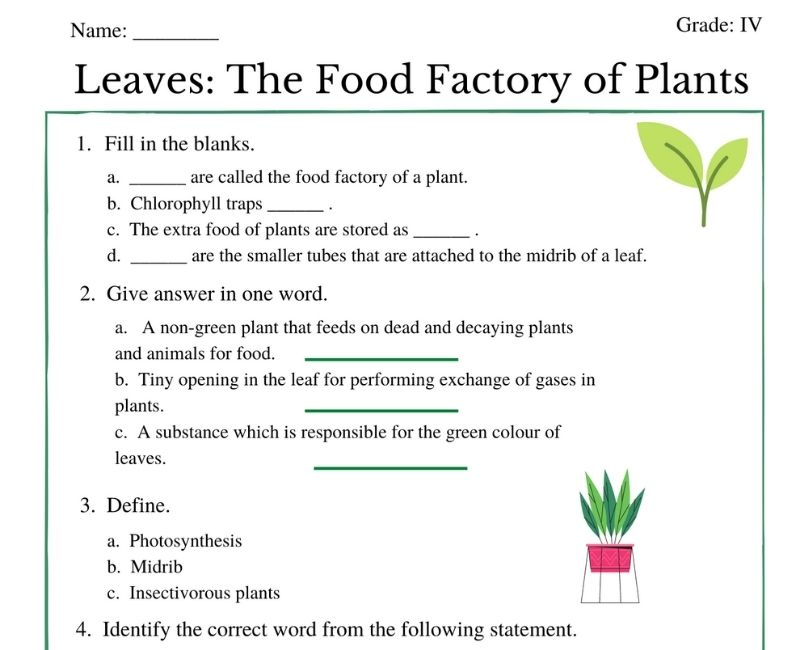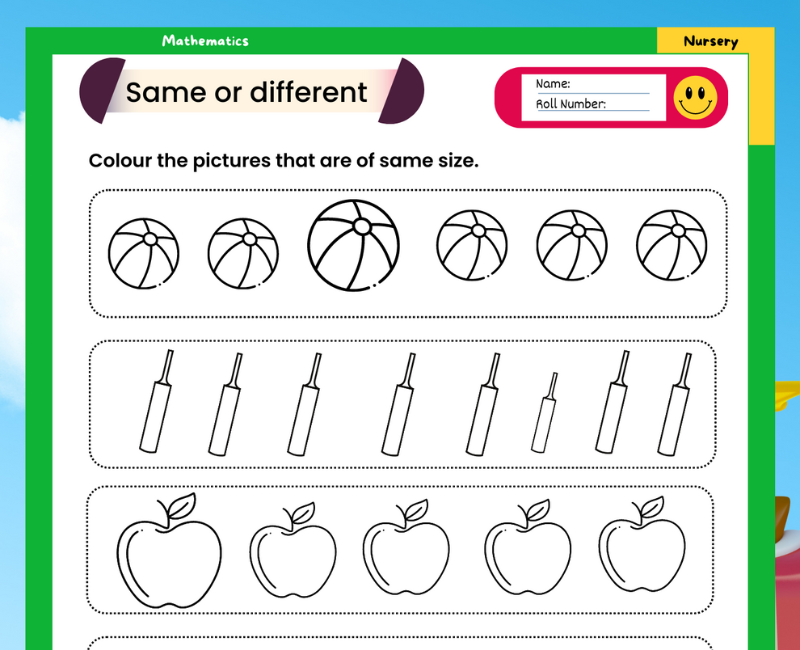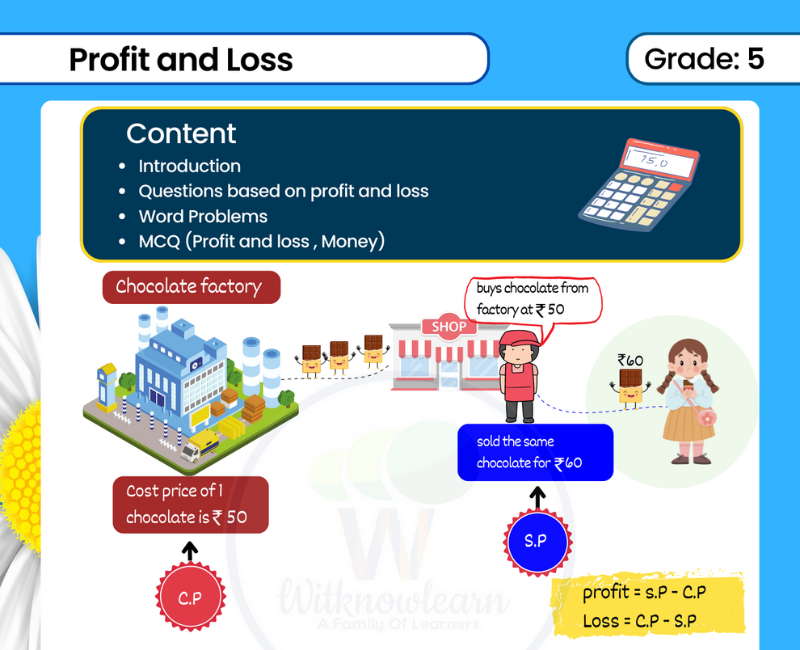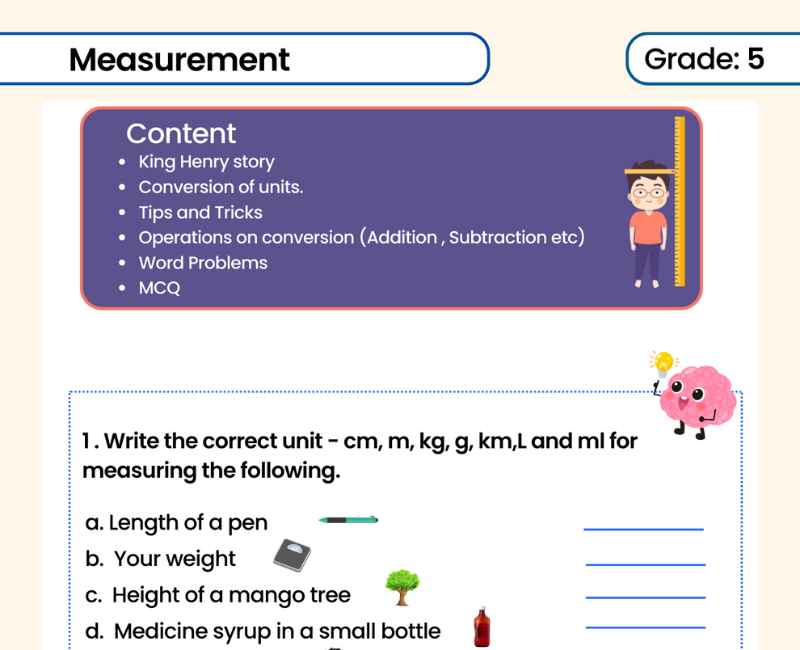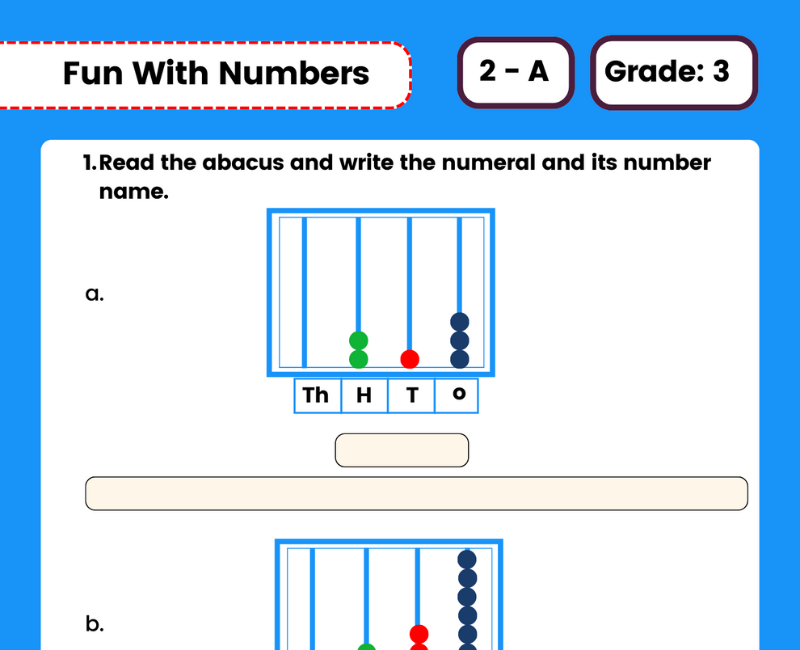Leaves and the Food Factory of Plants: Engaging Worksheets for Class 4 Students
Teaching your class 4 students about the role of leaves in the food factory of plants can be a fun and interactive experience with these worksheets. By exploring the process of photosynthesis and the importance of chlorophyll, your students will gain a deeper understanding of how plants produce their own food. Download these worksheets now to enhance your lesson plan.
Label the parts of a leaf.
One of the first steps in understanding the role of leaves in the food factory of plants is to identify and label the different parts of a leaf. This can be done through a simple worksheet activity where students are given a diagram of a leaf and asked to label the blade, petiole, veins, and other important parts. By doing this, students will have a better understanding of the structure of a leaf and how it functions in the process of photosynthesis.
Match the leaf to the correct plant.
This worksheet activity is a fun way for class 4 students to learn about different types of leaves and the plants they belong to. Students are given a set of pictures of leaves and a list of plants. They must match each leaf to the correct plant by drawing a line connecting them. This activity not only helps students identify different types of leaves, but also reinforces their knowledge of plant identification.
Fill in the blanks to complete the process of photosynthesis.
Photosynthesis is the process by which plants make their own food. It occurs in the chloroplasts of plant cells and involves the absorption of sunlight, carbon dioxide, and water. During photosynthesis, plants produce oxygen and glucose, which is a type of sugar.
The equation for photosynthesis is: carbon dioxide + water + sunlight → oxygen + glucose.
Draw and label the process of transpiration.
While transpiration is not directly related to photosynthesis, it is an important process that occurs in plants. Transpiration is the loss of water vapor from the leaves and stems of plants. It occurs through tiny pores on the surface of leaves called stomata. To draw and label the process of transpiration, students can create a diagram that shows a leaf with stomata, water entering the roots of the plant, and water vapor leaving the stomata. They can also label the different parts of the plant involved in transpiration, such as the roots, stem, and leaves.
Identify the different types of leaves and their functions.
Leaves are an important part of the food factory of plants, as they are responsible for photosynthesis. Photosynthesis is the process by which plants use sunlight, carbon dioxide, and water to produce glucose, which is used as food for the plant. Different types of leaves have different functions, such as broad leaves that are good at capturing sunlight, or needle-like leaves that are adapted to cold and dry environments. Students can learn about the different types of leaves and their functions by observing and comparing leaves from different plants, and by researching the adaptations of plants in different environments.
Why Leaves are called food factory of plants?
Leaves are called the food factory of plants because they are where the process of photosynthesis occurs. Photosynthesis is the process by which plants use sunlight, water, and carbon dioxide to produce glucose, which is the primary source of energy for the plant.
Leaves contain chloroplasts, which are organelles that contain chlorophyll, the pigment that absorbs sunlight. The chlorophyll in chloroplasts absorbs energy from the sun and converts it into chemical energy. The leaves also have tiny openings called stomata, which allow the plant to take in carbon dioxide from the air.
The carbon dioxide and water that the plant takes in are then used to produce glucose through the process of photosynthesis. The glucose is stored in the plant's cells and is used to power its metabolic processes, including growth and reproduction.
Without leaves, plants would not be able to produce glucose, and therefore, they would not be able to survive. Leaves are the site of glucose production, and they are the primary source of energy for the plant. This is why leaves are often referred to as the food factory of plants.
Plants are remarkable organisms that create their food through photosynthesis. Photosynthesis is the process by which plants use sunlight, water, and carbon dioxide to create their food. Leaves are an essential part of the plant that plays a vital role in the process of photosynthesis. Leaves are often referred to as the food factory of the plant.
So, how do plants use their food? Class 4 students often ask this question, and the answer lies in the process of photosynthesis. Plants make their food through photosynthesis, and the energy they produce is stored in the form of glucose. The plant uses this glucose to grow, reproduce, and carry out other life processes.
Speaking of how plants make their food, class 4 students must understand that it all begins with the leaves. Leaves have tiny openings called stomata, which allow the plant to take in carbon dioxide from the air. The plant also takes in water through its roots, which is transported to the leaves through tubes called xylem.
The leaves then use the energy from the sunlight to convert the carbon dioxide and water into glucose through a process called photosynthesis. This glucose is stored in the plant's cells and is used to power its metabolic processes. The oxygen produced during photosynthesis is released back into the atmosphere, which is vital for life on earth.
So, why are leaves called the food factory of the plant? This is because leaves are where the process of photosynthesis occurs. They are the site of glucose production, which is the primary source of energy for the plant. Without leaves, plants would not be able to create their food and survive.
To reinforce their understanding, class 4 students can engage in worksheets and MCQs that help them understand why leaves are called the food factory of plants. These resources can help students understand the role of leaves in photosynthesis and how the plant uses the energy it produces.
In conclusion, leaves are known as the food factories of plants, and they play a crucial role in the process of photosynthesis. They are the site of glucose production, which is the primary source of energy for the plant. Without leaves, plants would not be able to create their food and survive. Class 4 students must understand the process of photosynthesis and the importance of leaves in the plant's survival.
Leaves the food factory of plants class 4 questions and answers
What is photosynthesis?
Answer: Photosynthesis is the process by which plants use sunlight, water, and carbon dioxide to create their food.
What is the role of leaves in photosynthesis?
Answer: Leaves are where the process of photosynthesis occurs. They contain chloroplasts, which use energy from the sun to convert carbon dioxide and water into glucose.
Why are leaves called the food factory of plants?
Answer: Leaves are called the food factory of plants because they are the site of glucose production, which is the primary source of energy for the plant.
How do plants make their food?
Answer: Plants make their food through photosynthesis, where they use energy from the sun, water from the soil, and carbon dioxide from the air to produce glucose.
What happens to the oxygen produced during photosynthesis?
Answer: The oxygen produced during photosynthesis is released back into the atmosphere, which is essential for life on earth.
What are stomata, and what is their role in photosynthesis?
Answer: Stomata are tiny openings on the surface of leaves that allow the plant to take in carbon dioxide from the air. They also release oxygen produced during photosynthesis.
What happens to the glucose produced during photosynthesis?
Answer: The glucose produced during photosynthesis is stored in the plant's cells and is used to power its metabolic processes, including growth and reproduction.
Can plants survive without leaves?
Answer: No, plants cannot survive without leaves because they are essential for the process of photosynthesis, which is necessary for the plant's survival.
How do plants transport water from the roots to the leaves?
Answer: Plants transport water from the roots to the leaves through tubes called xylem.
What is the importance of photosynthesis for life on earth?
Answer: Photosynthesis is essential for life on earth because it produces oxygen, which is necessary for the survival of most living organisms, and it is the basis of the food chain for almost all living things.
Leaves the food factory of plants class 4 mcq
Which part of the plant is known as the food factory?
a) Roots b) Leaves c) Stem d) Flower
Which gas is needed by the plant to make food in its leaves?
a) Nitrogen b) Oxygen c) Carbon dioxide d) Hydrogen
What is the process called by which plants make food in their leaves?
a) Photosynthesis b) Respiration c) Transpiration d) Germination
What is the main food made by plants in their leaves during photosynthesis?
a) Glucose b) Protein c) Fat d) Vitamins
Which part of the leaf is responsible for trapping sunlight during photosynthesis?
a) Stomata b) Veins c) Chloroplasts d) Epidermis
Answers:
- b) Leaves
- c) Carbon dioxide
- a) Photosynthesis
- a) Glucose
- c) Chloroplasts
Leaves are the food factory of plants true or false
- Leaves are the site of glucose production in plants. (True)
- Photosynthesis is the process by which plants produce glucose. (True)
- Leaves are not essential for the survival of plants. (False)
- The primary source of energy for plants is oxygen. (False)
- Stomata are the openings on the surface of leaves that allow plants to take in carbon dioxide. (True)
- Chloroplasts are organelles that contain the pigment chlorophyll, which absorbs energy from the sun. (True)
- Glucose is stored in the plant's cells and is used to power its metabolic processes. (True)
- Without leaves, plants would not be able to produce glucose. (True)
- The oxygen produced during photosynthesis is stored in the plant's cells. (False)
- Leaves are called the food factory of plants because they are where the process of respiration occurs. (False)
Leaves the food factory of plants class 4th Notes
Leaves are an essential part of the plant that plays a vital role in the process of photosynthesis.
Photosynthesis is the process by which plants use sunlight, water, and carbon dioxide to create their food.
Leaves are often referred to as the food factory of the plant because they are where the process of photosynthesis occurs.
Chloroplasts in the leaves use energy from the sun to convert carbon dioxide and water into glucose.
Stomata on the surface of the leaves allow the plant to take in carbon dioxide from the air and release oxygen.
Glucose produced during photosynthesis is stored in the plant's cells and is used to power its metabolic processes, including growth and reproduction.
Without leaves, plants would not be able to produce glucose, and therefore, they would not be able to survive.
Leaves are the primary site of glucose production and the primary source of energy for the plant.
Students can use worksheets and MCQs to reinforce their understanding of the process of photosynthesis and the importance of leaves in the plant's survival.
It is crucial for class 4 students to understand the process of photosynthesis and the role of leaves in the plant's survival.
